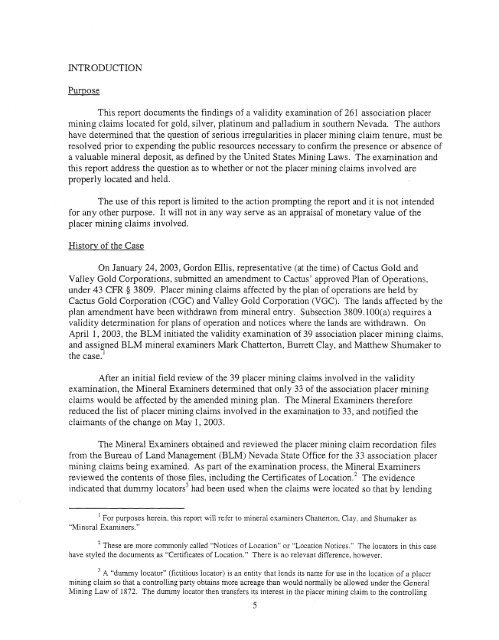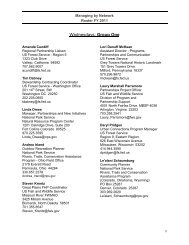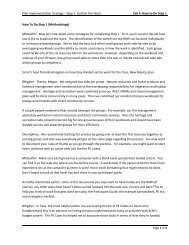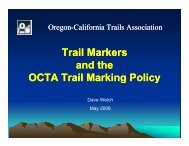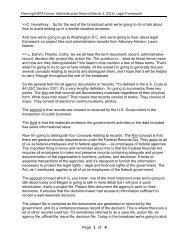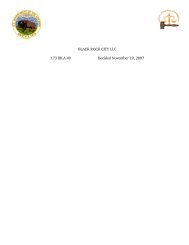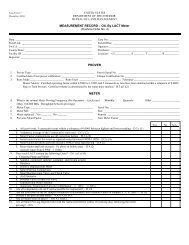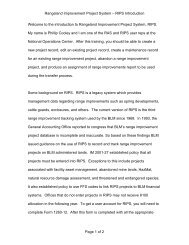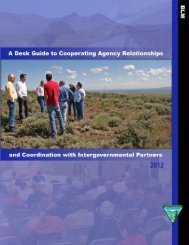- Page 1 and 2: UNITED STATES DEPARTMENT OF THE INT
- Page 3 and 4: Maps Map 1 Map 2 Claims Located by
- Page 5 and 6: By these actions, the evidence indi
- Page 7: BLM Recordation No. NMC Claim Name
- Page 11 and 12: Appendix 3 shows that two use autho
- Page 13 and 14: usiness relationship. That relation
- Page 15 and 16: Pilot Plant. Inc. Pilot Plant, Inc.
- Page 17 and 18: officers, March 22, directors, and
- Page 19 and 20: Table 7 - Corporate Officers in Cac
- Page 21 and 22: acre claims. While each point of ev
- Page 23 and 24: The lack of any evident contributio
- Page 25 and 26: not required to sign the location d
- Page 27 and 28: Map 1 Location Map Clark County, Ne
- Page 29 and 30: ap 3 - (aims Ioca-te Agents U Claim
- Page 31 and 32: Appendix 2 Paae 1 of 9 ~aaes Survey
- Page 33 and 34: Appendix 2 Pane 3 of 9 panes Survey
- Page 35 and 36: Appendix 2 Paae 5 of 9 ~aaes Survey
- Page 37 and 38: A~~endix 2 Paae 7 of 9 ~aaes Survey
- Page 39 and 40: Appendix 2 Paae 9 of 9 ~aae Survey
- Page 41 and 42: RUNTIME: 11 :18 AM UNITED STATES DE
- Page 43 and 44: RUNTIME: 11 :I 8 AM UNITED STATES D
- Page 45 and 46: , . RUNTIME: 11 :18 AM UNITED STATE
- Page 47 and 48: RUNTIME: 01 :40 PM Section 003 003
- Page 49 and 50: RUNTIME: 01 :40 PM Section 003 003
- Page 51 and 52: , RUNTIME: 01 :4O PM Section 003 00
- Page 53 and 54: RUNTIME: 01 :43 PM UNITED STATES DE
- Page 55 and 56: - Mer Township 21 0280s 21 0280s 21
- Page 57 and 58: RUNTIME: 0151 PM 4 - UNITED STATES
- Page 59 and 60:
RUNTIME: 02:OO PM UNITED STATES DEP
- Page 61 and 62:
RUNTIME: 02:02 PM UNITED STATES DEP
- Page 63 and 64:
PUBLIC LAW 107-282-NOV. 6,2002 CLAR
- Page 65 and 66:
PUBLIC LAW 107-282-NOV. 6, 2002 116
- Page 67 and 68:
PUBLIC LAW 107-282-NOV. 6, 2002 116
- Page 69 and 70:
PUBLIC LAW 107-282-NOV. 6,2002 116
- Page 71 and 72:
PUBLIC LAW 107-282-NOV. 6,2002 116
- Page 73 and 74:
PUBLIC LAW 107-282-NOV. 6,2002 116
- Page 75 and 76:
PUBLIC LAW 107-282-NOV. 6,2002 116
- Page 77 and 78:
PUBLIC LAW 107-282-NOV. 6,2002 116
- Page 79 and 80:
PUBLIC LAW 107-282-NOV. 6,2002 116
- Page 81 and 82:
PUBLIC LAW 107-282-NOV. 6,2002 116
- Page 83 and 84:
PUBLIC LAW 107-282-NOV. 6, 2002 116
- Page 85 and 86:
PUBLIC LAW 107-282-NOV. 6,2002 116
- Page 87 and 88:
PUBLIC LAW 107-282-NOV. 6,2002 116
- Page 89 and 90:
PUBLIC LAW 107-282-NOV. 6,2002 116
- Page 91 and 92:
PLAN MAINTENANCE LAS VEGAS F'IELD O
- Page 93 and 94:
Areas of Critical Environmental Con
- Page 95 and 96:
sec. 32, All. 5. Big Dune Total Acr
- Page 97 and 98:
sec. 15, All; sec. 16, All; secs. 2
- Page 99 and 100:
sec. 35. T. 19 S.. R 65 E.. sec. 2,
- Page 101 and 102:
Topographic Map. This map is in the
- Page 103 and 104:
P.L. 107.282 (1 16 Stat. 2009) ACEC
- Page 105 and 106:
sec. 9, sec. 10, sec. 16, sec. 17,
- Page 107 and 108:
* The Gold Butte Back Country Byway
- Page 109 and 110:
TOWNSHIP 28 SOUTH RANGE 64 EAST OF
- Page 111 and 112:
A~~endix 6 Master Title Plats Paae
- Page 113:
A~pendix . me 6 Mgster Tjtle Plats
- Page 116 and 117:
Mining Claim List, by Location Date
- Page 118 and 119:
Mining Claim List, by Location Date
- Page 120 and 121:
Mining Claim List, by Location Date
- Page 122 and 123:
Mining Claim List, by Location Date
- Page 124 and 125:
Mining Claim List, by Location Date
- Page 126 and 127:
Mining Claim List, by Location Date
- Page 128 and 129:
Mining Claim List, by Recordation N
- Page 130 and 131:
Mining Claim List, by Recordation N
- Page 132 and 133:
Mining Claim List, by Recordation N
- Page 134 and 135:
This page is INTENTIONALLY BLANK
- Page 136 and 137:
This page is INTENT IQNALLY BLANK
- Page 138 and 139:
This page is I13TENTIONALCY BUNK
- Page 140 and 141:
A~~endix 9 Paae 2 of 6 ~aaes Corpor
- Page 142 and 143:
LIST OF OFFICERS, DIRECTORS AND AGE
- Page 144 and 145:
CERTIFICATE OF REINSI'ATEMEKT 1, DE
- Page 146 and 147:
Filing k. );lLtU THE MFICE THE A rt
- Page 148 and 149:
LIST OF OFFICERS, DIRECFORS AND AGE
- Page 150 and 151:
CERTIFICATE OF REINSTATEMENT I, DEA
- Page 152 and 153:
fWxD H THE OFFICE OF THE SECRETARY
- Page 154 and 155:
LIST OF OFFICERS, DIREClDRS AND AGE
- Page 156 and 157:
CERTIFICATE OF REINSTATEMENT I, DEA
- Page 158 and 159:
IAN MATHESON 2215 LUCERNE CIRCLE HE
- Page 160 and 161:
LIST OF OFFICERS. DIRECVORS AND AGE
- Page 162 and 163:
CERTIFICATE OF REINSTATEMENT I, DEA
- Page 164:
LED Articles of Incorporation :;: c
- Page 167 and 168:
A NEVADA CORPORiTION INCORPORATED O
- Page 169 and 170:
FCR THE PERIOD JUL 1997 TO 1998. DU
- Page 171 and 172:
GEOSEARCH INC. FOR THE PERIOD JUL 1
- Page 173:
DEANHELLER Secretary of State J 101
- Page 177 and 178:
. , Page: 1 Document Name: untitled
- Page 179 and 180:
SIXTY DAY LIST OF OFFICERS, DIRECTO
- Page 181 and 182:
A NEVADA CORPOSI~ION INCORPORATEO O
- Page 183 and 184:
MINCOR INC. F3R THE PERIOD JUL 1997
- Page 185 and 186:
FOR THE PERIOD JUL 1999 TO 2000. DU
- Page 187 and 188:
DEAN HELLER Secretary of State 101
- Page 189 and 190:
FOR THE PERIOD JUL 2002 TO 2003. DU
- Page 191 and 192:
Page: 1 Document Name: untitled NAM
- Page 193 and 194:
SIXTY DAY LIST OF OFFICERS, DIRECTO
- Page 195 and 196:
L 1- 215 LUCFRNE CIR HfPOEQS3N d~b
- Page 197 and 198:
FOR THE PERIOD JUL 1997 TO 1998. DU
- Page 199 and 200:
GEOTECH MINING INC. FOR THE PERIOD
- Page 201 and 202:
4NNLIAL LIST OF OFFICERS, DIRECTORS
- Page 203 and 204:
ANNU&L LIST OF OFFICERS, DIRECTORS
- Page 205 and 206:
Date: 02/17/04 Time: 14:37:37 , 1 D
- Page 207 and 208:
C ;I. ;La 1 2 3 4 5 6 7 8 9 I0 11 1
- Page 209 and 210:
STATE NI MAR 6QI)CTIFICATE OF ACCEP
- Page 211 and 212:
- corporate Data: Pilot Plmt Page 7
- Page 213:
LIST OF OfFIqERq DIRECTORS AND AGEN
- Page 216 and 217:
- No. s7€ -- 3po ....."....-.....
- Page 218 and 219:
Appendix 16 Page 14 of 30 pages JAN
- Page 220 and 221:
3. , , , a (after Issuance of stock
- Page 222 and 223:
P" I -- Appendix // 16 Page 18 of 3
- Page 224 and 225:
FILE NUM -37 fq: P
- Page 226 and 227:
ANNUAL LIST OF OFFICERS, DIRECTORS
- Page 228 and 229:
1 FOR THE PERIOD MAR 2002 TO 2003.
- Page 230 and 231:
COLLlERS INTERNATIONAL PATRICK MCNA
- Page 232 and 233:
TO: P!' * 'i . MAW CHATTERTON, Assi
- Page 234 and 235:
Nevada Secretary of State Type: ~or
- Page 236 and 237:
Total presentation of the case cons
- Page 238 and 239:
The claims are situated on an alluv
- Page 240 and 241:
vegetation, yet he did not referenc
- Page 242 and 243:
himself to be an assayer, relied up
- Page 244 and 245:
Various witnesses for Contestees te
- Page 246 and 247:
amount of gold, with &imal investme
- Page 248 and 249:
Contestant proved at hearing that a
- Page 250 and 251:
assayed, at BLM's request, by Dr. P
- Page 252 and 253:
According to Mr. Matheson, they cou
- Page 254 and 255:
calculation assumes 100% gold recov
- Page 256 and 257:
high values. The reliability and re
- Page 258 and 259:
Charles Agq Contestees' main expert
- Page 260 and 261:
Brian Mountford (Ex. 84, fl14, 15;
- Page 262 and 263:
24). Mr. Matheson testified that he
- Page 264 and 265:
Despite this experience, he has thr
- Page 266 and 267:
fiquency waves, not gamma radiation
- Page 268 and 269:
In an apparent attempt to salvage h
- Page 270 and 271:
geology and metallurgy (see. e.p..
- Page 272 and 273:
They identified the small sample si
- Page 274 and 275:
metallurgical study focusing primar
- Page 276 and 277:
pores or be off-gad as vapor (Tr. v
- Page 278 and 279:
struk were accurately described by
- Page 280 and 281:
technique, including venting the fu
- Page 282 and 283:
In the present case, the incomplete
- Page 284 and 285:
easons (Tr. v. 18:3 110- 18). He te
- Page 286 and 287:
Dr. Pray's results are considered r
- Page 288 and 289:
depends upon many factors, some of
- Page 290 and 291:
must be based upon showings of mine
- Page 292 and 293:
State Office on July 24,2002 indica
- Page 294 and 295:
unreliable. Ex. A- 129. No. >Sample
- Page 296 and 297:
However, Mr. Matheson admitted that
- Page 298 and 299:
Mr. Matheson dated November 19,1997
- Page 300 and 301:
1.020 gold ounces per ton. This dat
- Page 302 and 303:
locations for the sampled material
- Page 304 and 305:
Split. were likewise processed and
- Page 306 and 307:
hm the claim. The affidavit and the
- Page 308 and 309:
Dr. Yen's work cannot be considered
- Page 310 and 311:
estimate of the weight of the excav
- Page 312 and 313:
proffered by any other individual a
- Page 314 and 315:
Contestees should be afforded fixhe
- Page 316 and 317:
In support of their argument that B
- Page 318 and 319:
Although Contestees argue otherwise
- Page 320 and 321:
efining is not necessary to prove a
- Page 322 and 323:
sand, because it best resembled mat
- Page 324 and 325:
Handbook for Mind Examiners (H-3890
- Page 326 and 327:
"Tonnage" (350)(3M)(16.6)(1.5) = 3,
- Page 328 and 329:
"an erratic distribution of mineral
- Page 330 and 331:
This page is INTENTIONALLY BLANK
- Page 332 and 333:
MAY 08 OF NEVADA Alrxla OF MCORPOIU
- Page 334 and 335:
director constituting the fht Board
- Page 336 and 337:
FILED ' WMErnOFTHE of STATE OF Tmi
- Page 338 and 339:
LIST OF OFFICERS, DIRECTORS AND AGE
- Page 340 and 341:
File No. 5057-1993 STATEMENT OF RES
- Page 342 and 343:
of Appointment . J by (mailing. add
- Page 344 and 345:
AUG 0 9 2WO CERTIFICATE OF AMENDMEN
- Page 346 and 347:
, . DEAN HELLER Secretary of State
- Page 348 and 349:
Appendix 18 Page 18 of 27 pages Cor
- Page 350 and 351:
ARTICLE m Governing Board 3.1 Direc
- Page 352 and 353:
- RLE NUMB CACTUS GOLD FOR THE PER1
- Page 354 and 355:
DEAN HELLER Secretary of State orri
- Page 356 and 357:
ANNUAL LIST OF OFFICERS, DIRECTORS
- Page 358 and 359:
This page is INTENTIONALLY BLANK
- Page 360 and 361:
No. The underrrigned, for the purpo
- Page 362 and 363:
(b) The payment of distributions in
- Page 364 and 365:
EiLED * !N TI6 OFFICE C' THE SECRET
- Page 366:
I (31VO) 0371j - - -- : L - A ~NO n
- Page 369 and 370:
'FOR THE PERIOD AUG 1999 TO 2000. D
- Page 371 and 372:
, I STATE OF: NEVADA SECRETARY OF S
- Page 373 and 374:
fw oetclrrrnb~ (PunuMt to NRS) - Re
- Page 375 and 376:
C.NtiUAL LIST OF OFFICERS, DIRECTOR
- Page 377 and 378:
Summary of Transfers of Interest, S
- Page 379 and 380:
Summary of Transfers of Interest, S
- Page 381 and 382:
Summary of Transfers of Interest, S
- Page 383 and 384:
Summary of Transfers of interest, S
- Page 385 and 386:
Summary of Transfers of Interest, S
- Page 387 and 388:
Summary of Transfers of Interest, S
- Page 389 and 390:
Summary of Transfers of Interest, S
- Page 391 and 392:
Summary of Transfers of Interest, S
- Page 393 and 394:
Summary of Transfers of interest, S
- Page 395 and 396:
Summary of Transfers of Interest, S
- Page 397 and 398:
Summary of Transfers of Interest, S
- Page 399 and 400:
Summary of Transfers of Interest, S
- Page 401 and 402:
Summary of Transfers of Interest, S
- Page 403 and 404:
Summary of Transfers of Interest, S
- Page 405 and 406:
Summary of Transfers of Interest, S
- Page 408 and 409:
Summary of Transfers of Interest, S
- Page 410 and 411:
Summary of Transfers of Interest, S
- Page 412 and 413:
Summa y of Transfers of Interest, S
- Page 414 and 415:
Summary of Transfers of interest, S
- Page 416 and 417:
Summary of Transfers of Interest, S
- Page 418 and 419:
Summary of Transfers of interest, S
- Page 420 and 421:
Summary of Transfers of interest, S
- Page 422 and 423:
Summary of Transfers of Interest, S
- Page 424 and 425:
Summary of Transfers of Interest, S
- Page 426 and 427:
Summary of Transfers of Interest, S
- Page 428 and 429:
Summary of Transfers of Interest, S
- Page 430 and 431:
Summary of Transfers of Interest, S
- Page 432 and 433:
Summary of Transfers of Interest, S
- Page 434 and 435:
Summary of Transfers of Interest, S
- Page 436 and 437:
Summary of Transfers of Interest, S
- Page 438 and 439:
Summary of Transfers of interest, S
- Page 440 and 441:
Summary of Transfers of Interest, S
- Page 442 and 443:
Summary of Transfers of Interest, S
- Page 444 and 445:
Summary of Transfers of Interest, S
- Page 446 and 447:
Summary of Transfers of Interest, S
- Page 448 and 449:
Summary of Transfers of Interest, S
- Page 450 and 451:
Summary of Transfers of Interest, S
- Page 452 and 453:
Summary of Transfers of Interest, S
- Page 454 and 455:
Summary of Transfers of Interest, S
- Page 456 and 457:
Summary of Transfers of interest, S
- Page 458 and 459:
Summary of Transfers of interest, S
- Page 460 and 461:
Summary of Transfers of Interest, S
- Page 462 and 463:
Summary of Transfers of Interest, S
- Page 464 and 465:
This page is INTENTIONALLY BLANK
- Page 466 and 467:
SCALE : 1" 500' LOCATION, : 264V GR
- Page 468 and 469:
LOCATION 2640' MONUMENT-. BLUE 6704
- Page 470 and 471:
Placer Mining Claim Map . - Scale 1
- Page 472 and 473:
TO: THE UNITED STATE DEPARTMENT OF
- Page 474 and 475:
: THE UNITED STATES DEPARTMENT OF T
- Page 476 and 477:
DEED TO PLACER MIMING CLAIMS THIS D
- Page 478 and 479:
EXHIBIT A CLAIM NAME ELDORADO PROJE
- Page 480 and 481:
ELDORADO PROJECT PLACER CLAIMS PAGE
- Page 482 and 483:
CLAIM NAME ELDORADO PROJECT PLACER
- Page 484 and 485:
Deed to Placer Mining Claims THIS D
- Page 486 and 487:
Deed to Placer Mining Claims THIS D
- Page 488 and 489:
Deed to Placer Mining Claims WHEREA
- Page 490 and 491:
Deed to Placer Mining Claims I THfS
- Page 492 and 493:
Exhibit "A" COUNT CLAIM NAME QUARTE
- Page 494 and 495:
* lf /2~j2b00 06: 55 78256327 ;6 AN
- Page 496 and 497:
Page 1 of 1 Licensing Internet Quer
- Page 498 and 499:
I ! D.te.-szrr..$!q .--...... TEMPO
- Page 500 and 501:
Section 1.1. Tha MM of the corporat
- Page 502 and 503:
(b) The payment of distributions in
- Page 504 and 505:
4 FILED IN THE Of FlCE OF THE SECRE
- Page 506 and 507:
all filhq fiier, licenses, penaltie
- Page 508 and 509:
'4c LIST OF OFFICERS, DIRECTORS AND
- Page 510 and 511:
CACTUS MINING CORP. OR THE PERIOD A
- Page 512 and 513:
I I t'nY-82-1981 03:09 P. 03 . - .,
- Page 514 and 515:
'OR THE PERIOD AUG 2002 TO 2003. DU
- Page 516:
This page is INTENTIONALLY BLANK


